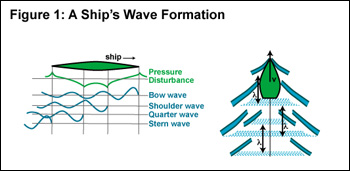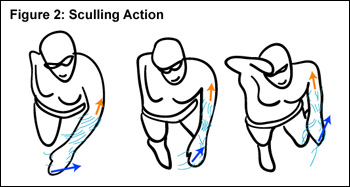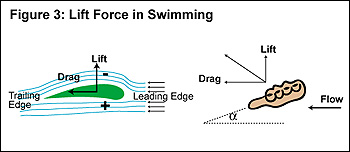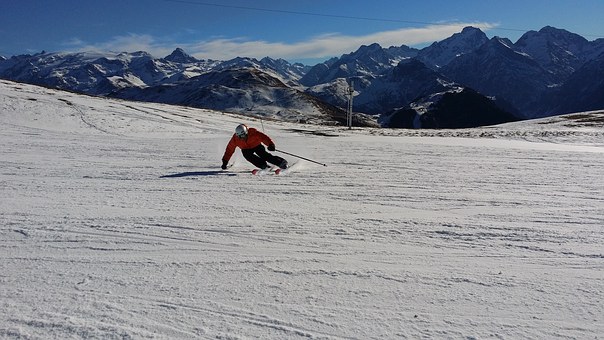Tricia Gibo was a junior studying Biomedical-Mechanical Engineering at the University of Southern California in the fall of 2005. In her free time, she enjoys playing the piano, snowboarding, and swimming.
In a sport where a hundredth of a second can make all the difference, swimmers are constantly looking for ways to increase the efficiency of their stroke and improve their times. However, the physical force of drag remains a swimmer’s ultimate obstacle. There are multiple forms of drag – friction, pressure, and wave – and swimmers must constantly battle all three from the second they enter the water to their final touch at the wall. To maximize a swimmer’s efforts, research has been conducted to analyze and improve stroke technique. In addition, engineering technology has stepped in by introducing new advancements in swimsuit design.
Introduction
For most people, a few minutes is not a long time. A couple of seconds? Trivial. And a few hundredths of a second? Forget about it. But to a swimmer, this minuscule difference in time can mean the difference between winning the race and receiving second place. Any means of increasing a swimmer’s efficiency and speed is vital. However, this is not such an easy task, as swimmers have multiple forces of nature working against them, mainly drag. Swimmers have been searching for ways to improve their stroke and reduce their times for years, but now scientists have joined them in their quest. With intensive research, modeling, and cutting-edge technology, the sport of swimming has been thoroughly analyzed and the techniques of swimmers have improved. In effect, precision in specific aspects of the strokes and new advancements in swimsuit design have been employed to combat the impeding forces faced by swimmers.
Physics Can Be a Drag
Anyone who has attempted to wade through water has felt the hindering force of drag. Drag places great limitations on swimmers, whose main goal is to race across the pool as quickly as possible. Unfortunately, water is more than 700 times denser and 55 times more viscous than air, meaning that water has a higher resistance to flow and is more difficult to maneuver through [1]. These qualities of water contribute to the force that swimmers must constantly battle – drag. Drag consists of the total resistive force on a body opposing the motion of the body through some medium (in this case, water). The force of drag depends on many factors, including the density of the fluid, velocity of the moving body, and the surface area of the object. Drag is felt not only by swimmers, but also by bicyclists, airplanes, automobiles, and all other moving objects. However, in an aqueous medium, these forces are greatly amplified.
There are three main types of drag felt by a swimmer: friction, pressure, and wave drag. Frictional drag is due to the constant collision and rubbing of the swimmer’s body against the surrounding water molecules (Fig. 1). Even at low speeds, these interactions serve to slow down the swimmer, preventing forward motion. While friction can induce the restraints of drag, it is also necessary to propel the swimmer. To an extent, as the swimmer pushes against the water, the water pushes against the swimmer in return. However, with increased propulsion also comes increased frictional drag.
[image=640 file=”ii7_142_swimming_fig1-350×148.jpg” placement=”center”]Figure 1: Development of Fictional Drag[/image]As a swimmer begins to build up speed, pressure drag begins to come into play, further acting against the swimmer. While swimming at higher speeds, water begins to build up around the swimmer’s head. Consequently, there is an increase of pressure in the frontal region, creating a pressure difference between the two ends of the swimmer’s body [2]. This pressure difference generates turbulence–an apparently random, chaotic flow of water–behind the swimmer’s body that is felt as additional resistance.
At racing speeds, the swimmer also becomes hindered by wave drag, which occurs when an object attempts to move through the surface of a liquid. While cutting through the water surface at high speeds, the pressure around the swimmer increases due to the difference in water velocities directly around his or her body. The swimmer in turn creates waves, similar to the formation of waves due to a ship (Fig. 2) [2].
Wave drag can be challenging for swimmers, as increased speed leads to intensified wavelength and amplitude (height) of the resulting waves. Therefore, more waves and resistance are created as the swimmer picks up speed. At certain speeds, the wavelength equals the length of the swimmer’s body, creating a “pocket” around the swimmer. Attempting to swim out of this furrow of water only increases the wave amplitude even more; thus, the swimmer only digs further into the trough and expends more energy. As a result, wave drag places great limits on the speeds swimmers are able to effectively reach.
With the forces of drag working against them, swimmers constantly search for methods to reduce the hindering effect of the laws of physics. Swimmers can best control the amount of drag by reducing the frontal cross-sectional area facing their direction of motion and considering the outer surfaces of their exposed skin and swimsuit. In fact, by using certain specialized technologies swimmers can actually utilize these forces of physics to their advantage.
A Race Against the Forces of Physics
Even from the beginning of a race, right off the starting blocks, swimmers can successfully reduce their drag by streamlining underwater. Streamlining requires swimmers to maintain a straight, tight body position, legs together and arms outstretched with hands adjoined and biceps right next to their ears. This technique, used after dives and flip turns, serves to reduce drag by limiting the frontal area of the body exposed in the direction of motion. By remaining beneath the surface of the water, swimmers can also avoid wave drag.
The main battle against drag begins with the first arm stroke. For simplicity, this article will only focus on freestyle, although applications can be found in any of the four official strokes of swimming. One of the main components of efficient swimming is the pull, creating propulsion due to the arm strokes. Initially, it was believed that drag was actually the main force in assisting the swimmer’s pull. By pulling the hand straight back through the water, the drag force would occur in the opposite direction of this motion. Thereby utilizing Newton’s 3rd Law (for every action, there is an equal and opposite reaction), the swimmer would push back on the water and the water would consequently drive the swimmer forward. However, this method of pulling was eventually proven ineffective and less energy efficient. The force of drag in fact serves to hinder more than aid the swimmer, creating turbulence as high pressure builds behind the individual’s palm. Additionally, the swimmer expends unnecessary energy in pushing the water backwards, giving it kinetic energy that could have been used more efficiently.
A more effective pull uses an angled hand in a sculling (S-shaped) motion, utilizing the concept of lift (Fig. 3). The lift force felt by swimmers is comparable to the lift experienced by an airplane wing, but in the swimmer’s case it is the arm and hand that generate a forward lift used for propulsion. Due to the hand’s unique curvature and angle, water flowing near the hand must travel faster over the back of the hand than the palm region. Hence, there is greater pressure near the palm, resulting in the valuable lift force used to propel the swimmer forward. In addition, the S-shaped pull allows for a longer overall path, giving more time to the application of forces aiding the swimmer [3].
Other aspects of a swimmer’s pull can also help reduce the opposing drag forces (Fig. 4). By extending their arms with each stroke, swimmers can increase their body length. As a result, they encounter diminished wave resistance and are less likely to find themselves caught in a self-created trough. The glide between each arm stroke can also reduce wave formation by decreasing the amount of pressure accumulating near the head.
Another important component of the freestyle is the kick, where a swimmer’s hamstring and quadriceps muscles help to maintain balance and the necessary horizontal position in the water. By keeping their legs level with the rest of their body, swimmers can further reduce their frontal area and the resulting drag. In addition, the flutter kick also contributes to the forward propulsion of the swimmer, though the lift effect is not nearly as great as that of the pull.
Lastly, body position plays a major role in a swimmer’s attempt to minimize the forces of drag. While a streamlined profile is important, body roll can diminish the effects of wave interference. Body roll requires swimmers to rotate their body as they swim, partially turning to the side as they pull, rather than maintaining a flat body position while rotating their arms. With just the right degree of body roll, an efficient swimmer can create waves with smaller amplitudes and therefore reduce drag. Rolling one’s shoulders also helps to decrease frictional drag by minimizing the exposed frontal area. By examining such techniques, it can be understood why athletes need not be excessively bulky or muscular in order to be strong, quick swimmers.
Engineering Peak Performances
Along with the perfection of stroke technique, swimmers have long attempted to reduce drag by changing their outer appearance – wearing caps, sporting tight-fitting swimsuits, and engaging in the ritual “shave down” (shaving of the entire body). The main goal of these activities is to reduce the frictional drag on the swimmer.
Water molecules closest to the body experience high levels of friction, especially near the contours of the swimmer’s body. There comes a point when the water further away from the body begins to move much faster and the water molecules adjacent to the body remain stationary. The region directly behind this spot will experience a backflow of water, holding the swimmer back [4]. This rise in frictional drag leads to the increase in pressure difference around the swimmer’s body, so pressure drag is amplified as well.
The newly engineered swimwear designs help to combat these retarding forces. The major improvement is aimed at reducing the friction due to the flow of water against the swimmer’s body. Speedo’s Fastskin suit is designed to mimic the hydrodynamic efficiency of shark skin. The V-shaped ridges along the swimsuit are intended to direct the flow of water over the swimmer’s body more effectively. These ridges are placed in front of the regions where backflow is known to occur. The shape of the V’s creates turbulence that mixes the slower moving particles with the faster water molecules. This turbulence reduces the pressure difference between the separate layers of water flow [4], and therefore decreases pressure drag.
Many other developments have also been made in swimwear to increase the efficiency of swimmers. For instance, the “Fullbody” by Adidas Equipment is designed with comfortable seams and compressive fabric, with the hopes of reducing muscle fatigue. Arena also designed its Powerskin suit using hydrophobic (water-repelling) material. Thus, less water is absorbed, resulting in a lighter swimsuit [5]. As evident with these various swimsuits, the collaboration of athletics and engineering has only just begun.
Conclusion: And the Race Continues
With the ongoing research and development invested in swimming, and the inexhaustible force of drag forever plaguing these athletes, the race for finding faster and more efficient means of swimming will continue. Some have argued, however, that the sport has become too reliant on technology and external modifications as new swimsuit designs help only those who are able to afford these expensive suits. Where does one draw the line, and how different is this to allowing swimmers to essentially swim with fins? Despite these objections, further progress will be made in the sport of swimming as swimmers strive to improve both themselves and the advancement of their sport.
References
[1] V. Mallette. The Science of the Summer Games. Rockland, MA: Charles River Media, Inc., 1996.
[2] E. Stevens, M. van Stralen, and H. Toussaint. “Wave Drag in Front Crawl Swimming”. Amsterdam, The Netherlands: Vrije Universiteit, Institute of Fundamental and Clinical Human Movement Science, 2003.
[3] “Fluid Dynamics of Swimming.” The National Business Aviation Association. Internet: http://wings.avkids.com/Book/Sports/instructor/swimming-01.html. Jun. 16, 1997.
[4] H. Toussaint. “The Fast-Skin ‘Body’ Suit: Hip, Hype, But Does it Reduce Drag During Front Crawl Swimming?” Amsterdam, The Netherlands: Vrije Universiteit, Institute of Fundamental and Clinical Human Movement Science, 2002.
[5] M. Leubbers. “The Y2K Swimsuit: The New Suit for the Century.” About, Inc. Internet: http://swimming.about.com/od/swimsuits/a/y2kswimsuit.htm. 2005.






